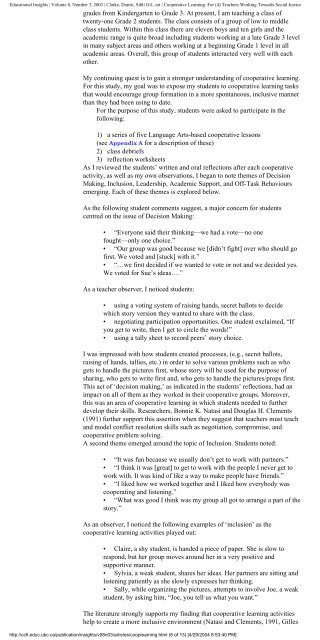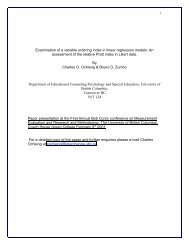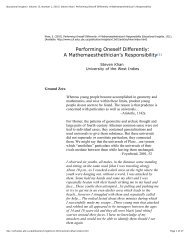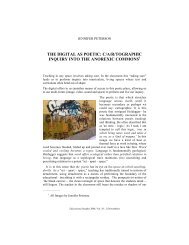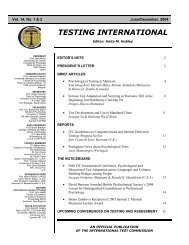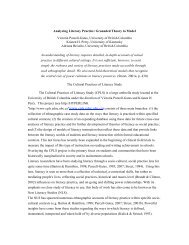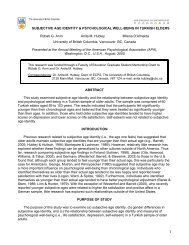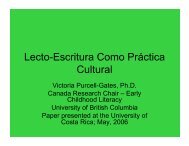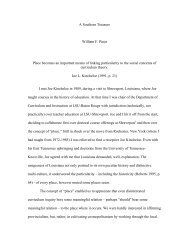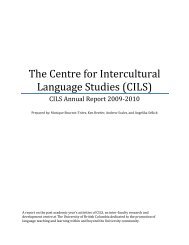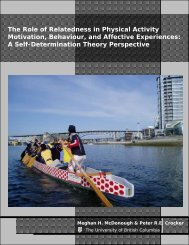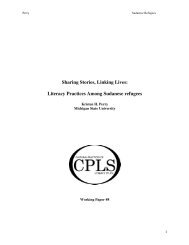Educational Insights | Volume 8, Number 3, 2003 | Clarke, Darrin ...
Educational Insights | Volume 8, Number 3, 2003 | Clarke, Darrin ...
Educational Insights | Volume 8, Number 3, 2003 | Clarke, Darrin ...
You also want an ePaper? Increase the reach of your titles
YUMPU automatically turns print PDFs into web optimized ePapers that Google loves.
<strong>Educational</strong> <strong>Insights</strong> | <strong>Volume</strong> 8, <strong>Number</strong> 3, <strong>2003</strong> | <strong>Clarke</strong>, <strong>Darrin</strong>, Sibli Gil...art | Cooperative Learning: For (4) Teachers Working Towards Social Justice<br />
grades from Kindergarten to Grade 3. At present, I am teaching a class of<br />
twenty-one Grade 2 students. The class consists of a group of low to middle<br />
class students. Within this class there are eleven boys and ten girls and the<br />
academic range is quite broad including students working at a late Grade 3 level<br />
in many subject areas and others working at a beginning Grade 1 level in all<br />
academic areas. Overall, this group of students interacted very well with each<br />
other.<br />
My continuing quest is to gain a stronger understanding of cooperative learning.<br />
For this study, my goal was to expose my students to cooperative learning tasks<br />
that would encourage group formation in a more spontaneous, inclusive manner<br />
than they had been using to date.<br />
For the purpose of this study, students were asked to participate in the<br />
following:<br />
1) a series of five Language Arts-based cooperative lessons<br />
(see Appendix A for a description of these)<br />
2) class debriefs<br />
3) reflection worksheets<br />
As I reviewed the students’ written and oral reflections after each cooperative<br />
activity, as well as my own observations, I began to note themes of Decision<br />
Making, Inclusion, Leadership, Academic Support, and Off-Task Behaviours<br />
emerging. Each of these themes is explored below.<br />
As the following student comments suggest, a major concern for students<br />
centred on the issue of Decision Making:<br />
• “Everyone said their thinking—we had a vote—no one<br />
fought—only one choice.”<br />
• “Our group was good because we [didn’t fight] over who should go<br />
first. We voted and [stuck] with it.”<br />
• “…we first decided if we wanted to vote or not and we decided yes.<br />
We voted for Sue’s ideas….”<br />
As a teacher observer, I noticed students:<br />
• using a voting system of raising hands, secret ballots to decide<br />
which story version they wanted to share with the class.<br />
• negotiating participation opportunities. One student exclaimed, “If<br />
you get to write, then I get to circle the words!”<br />
• using a tally sheet to record peers’ story choice.<br />
I was impressed with how students created processes, (e.g., secret ballots,<br />
raising of hands, tallies, etc.) in order to solve various problems such as who<br />
gets to handle the pictures first, whose story will be used for the purpose of<br />
sharing, who gets to write first and, who gets to handle the pictures/props first.<br />
This act of ‘decision making,’ as indicated in the students’ reflections, had an<br />
impact on all of them as they worked in their cooperative groups. Moreover,<br />
this was an area of cooperative learning in which students needed to further<br />
develop their skills. Researchers, Bonnie K. Natasi and Douglas H. Clements<br />
(1991) further support this assertion when they suggest that teachers must teach<br />
and model conflict resolution skills such as negotiation, compromise, and<br />
cooperative problem solving.<br />
A second theme emerged around the topic of Inclusion. Students noted:<br />
• “It was fun because we usually don’t get to work with partners.”<br />
• “I think it was [great] to get to work with the people I never get to<br />
work with. It was kind of like a way to make people have friends.”<br />
• “I liked how we worked together and I liked how everybody was<br />
cooperating and listening.”<br />
• “What was good I think was my group all got to arrange a part of the<br />
story.”<br />
As an observer, I noticed the following examples of ‘inclusion’ as the<br />
cooperative learning activities played out:<br />
• Claire, a shy student, is handed a piece of paper. She is slow to<br />
respond, but her group moves around her in a very positive and<br />
supportive manner.<br />
• Sylvia, a weak student, shares her ideas. Her partners are sitting and<br />
listening patiently as she slowly expresses her thinking.<br />
• Sally, while organizing the pictures, attempts to involve Joe, a weak<br />
student, by asking him, “Joe, you tell us what you want.”<br />
The literature strongly supports my finding that cooperative learning activities<br />
help to create a more inclusive environment (Natasi and Clements, 1991, Gilles<br />
http://ccfi.educ.ubc.ca/publication/insights/v08n03/articles/cooplearning.html (6 of 13) [4/29/2004 8:53:40 PM]


